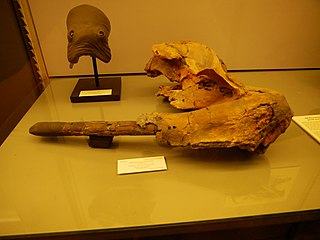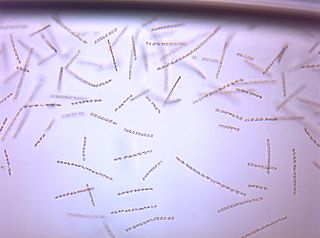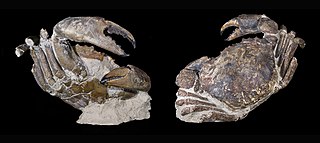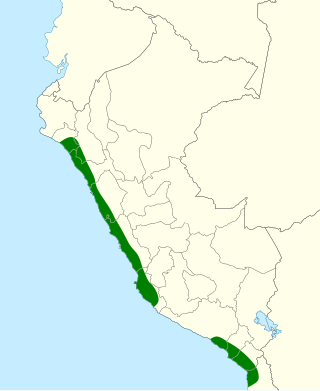
The pygmy beaked whale, also known as the bandolero beaked whale, Peruvian beaked whale and lesser beaked whale, is the smallest of the mesoplodonts and one of the newest discoveries. There were at least two dozen sightings of an unknown beaked whale named Mesoplodon sp. A before the initial classification, and those are now believed to be synonymous with the species. The species was formally described in 1991, based on ten specimens obtained from Peru between 1976 and 1989, including a 3.72 m (12.2 ft) adult male as the type specimen. A specimen that stranded at Paracas, Peru in 1955 has since been identified as a pygmy beaked whale. Since 1987, there have been an additional 40 sightings of the species, for a total of 65.

The Andean cock-of-the-rock, also known as tunki (Quechua), is a large passerine bird of the cotinga family native to Andean cloud forests in South America. It is widely regarded as the national bird of Peru. It has four subspecies and its closest relative is the Guianan cock-of-the-rock.

Odobenocetops is an extinct genus of small toothed whale known from Chile and Peru. Its fossils are found in Miocene-aged marine strata of the Bahía Inglesa Formation and Pisco Formation. Two species of Odobenocetops are currently recognized, O. peruvianus and the slightly younger O. leptodon.
Allobates peruvianus is a species of frog in the family Aromobatidae. It is found in Peru where it occurs on the lower Amazonian slopes of the Andes; its range possibly extends into adjacent Bolivia and Ecuador. Its natural habitats are premontane forests. It is threatened by habitat loss.
Pristimantis peruvianus is a species of frog in the family Strabomantidae. It is found in the upper Amazon Basin in western Brazil, southern Ecuador, eastern Peru, and southeast Colombia. Records from Bolivia likely refer to an undescribed species, although it is possible that also the "true" Pristimantis peruvianus is to be found there. Its natural habitats are upland cloud forests, flooded lowland forests, and oxbow palm swamp forests. It is a common species.
Telmatobius peruvianus, also known as the Peru water frog, is a species of frog in the family Telmatobiidae. This semiaquatic frog is endemic to Andean highlands in southeastern Peru and far northern Chile where found in streams and small rivers. It is threatened by habitat loss, pollution, collection for human consumption and infection by chytrid fungi, and it has not been seen in Chile since 1986.
Epicrionops peruvianus, the Marcapata Valley caecilian, is a species of caecilian in the family Rhinatrematidae endemic to Peru. Its natural habitats are subtropical or tropical moist montane forests, rivers, and intermittent rivers.

The Peruvian eagle ray is a species of fish in the family Myliobatidae. It is found in the Pacific Ocean off Chile and Peru. It can be differentiated from the similar Chilean eagle ray by color and rostral fin form. The ray has not been extensively studied, and is ranked as Data Deficient by the IUCN. It has been recorded only in the open ocean, but is considered likely to be a benthic feeder. It is thought by scientists to be similar to other myliobatids in terms of biology, habits, and threats.

Chaetoceros is a genus of diatoms in the family Chaetocerotaceae, first described by the German naturalist C. G. Ehrenberg in 1844. Species of this genus are mostly found in marine habitats, but a few species exist in freshwater. It is arguably the common and most diverse genus of marine planktonic diatoms, with over 200 accepted species. It is the type genus of its family.

Archaeogeryon is an extinct genus of crab from the Miocene, the type species in the genus is Archaeogeryon peruvianus. Despite the species name, the crab is only known from the Guadal Formation, Chile.

Cynthiacetus is an extinct genus of basilosaurid early whale that lived during the Late Eocene Specimens have been found in the southeastern United States and Peru.

Microlophus peruvianus, the Peru Pacific iguana, is a species of lava lizard endemic to the Ecuador, Peru, and Chile. The species is commonly attributed to the genus Microlophus but has been attributed to the genus Tropidurus.

Lobatus peruvianus, commonly known as the Peruvian conch or the cock's comb conch, is a species of large sea snail, a marine gastropod mollusk in the family Strombidae, the true conchs and their allies.
Oroperipatus peruvianus is a species of velvet worm in the Peripatidae family. Males of this species have 34 pairs of legs; females have 36 or 37. Female specimens range from 55 mm to 61 mm in length. The type locality is in Peru.

The Peruvian pipit is a species of bird in the family Motacillidae native to Chile and Peru.

Dermestes peruvianus, the Peruvian larder beetle, is a species of carpet beetle in the family Dermestidae. It is found in North America and Europe.
The Peru clawed gecko is a species of lizard in the Sphaerodactylidae family found in Peru and Colombia.
Polychrus peruvianus, the Peruvian bush anole, is a species of bush anole native to Peru and Ecuador. It was initially placed in the genus, Polychroides, before being corrected in 1965.
Exocoetus peruvianus, commonly known as the Peruvian flyingfish, is a species of ray-finned fish endemic to the tropical southeast Pacific Ocean in the waters off Peru and Ecuador.
Atractus peruvianus, the Peru ground snake, is a species of snake in the family Colubridae. The species can be found in Peru.











